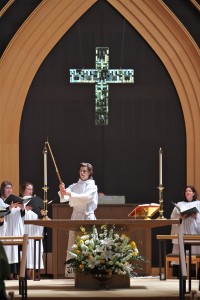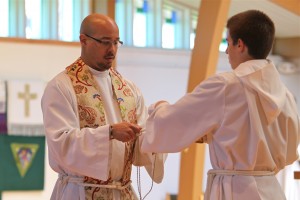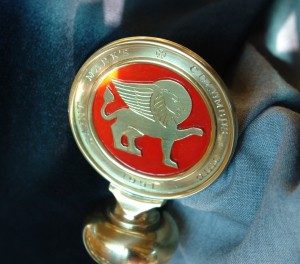What is an acolyte?
Acolytes are part of a very old tradition that dates back into the Third Century. Since the year 250 A.D acolytes have been people who served at the altar of God. The word “acolyte” itself comes from the Greek word “akolouthos” meaning “a follower” or “one who helps”.
In the Roman Church acolytes were once a minor ordained order, one of the so-called “Ministeria”. The Fourth Council of Carthage prescribed by canon (church law) their form of ordination: “When any acolyte is ordained, the bishop shall inform him how he is to behave in office; and he shall receive a candlestick with a taper in it from the archdeacon, that he may understand that he is appointed to light the candles of the church. He shall also receive an empty pitcher to furnish wine for the Eucharist of the Blood of Christ.”
Hence the earliest duties of acolytes involved living a life of ministry and service, as well as lighting the candles of the church, and assisting the Celebrant at the altar during the liturgy. The Acolytes of Saint Mark’s continue in this ancient tradition.
"I am among you as one who serves." - Jesus Christ
Leadership. Service.
The most important parts of this tradition for us today are Leadership and Service. Holy Scripture tells us that in order to lead we must first serve. The motto of Saint Mark’s acolytes comes from Christ’s own word’s: “I am among you as one who serves.” (Luke 22:29) 
Saint Mark’s acolytes are expected to be nothing less than the young leaders of the parish. They are to set an example for all young people through service to the church, to their family, and to the community.
Assisting at the altar each Sunday is an earned privilege – the crowning moment of a life dedicated to knowing and following Jesus Christ. By faithfully serving as members of Saint Mark’s Guild, acolytes will prepare themselves to be the future leaders of the church and of society.
How Do I Become an Acolyte?
Acolytes are trained several times each year by members of the Saint Mark’s Verger’s Guild. If you are interested in becoming an acolyte speak to any verger- or contact the Head Verger HERE.
The Liturgical Customary (or the worship service customs) give an overview of the role of each of the liturgical ministers. The customaries may be found on the Eucharistic worship page HERE.
The current Acolyte Manual is available
by selecting the prayer book icon below: 

What is a verger?
History
Vergers come from the Latin “virga” meaning “someone who precedes a dignitary in procession” (usually carrying a mace or some sign of office.) In the days when the church procession marched through the streets, the verger carried a sword in front of the Crucifer to see that no one got in the way of the cross of Christ. To this day many “verges” or the wands vergers carry incorporate a sword among the symbols depicted.
In the Anglican Church vergers are almost always present in cathedrals. They lead processions, organize service participants, and generally take responsibility for seeing that the liturgy of the church runs smoothly and as laid down by the Bishop or Dean.
Saint Mark’s vergers are members of the National Vergers Guild of the Episcopal Church, which is in association with the Church of England Guild of Vergers. Pictured on the above right are some charter members of Saint Mark’s Vergers Guild at the National Guild’s annual conference with VGEC president, David Jette.
Responsibilities
Saint Mark’s vergers are charged with seeing that the liturgy is conducted and unfolds in the manner the clergy have laid out in the Liturgical Customary. They have a leadership role in the service, lead the majority of the processions, and are proven masters of all other liturgical functions.
 Vergers also mentor the Crucifer – who is the leader of the acolyte team. Vergers are asked to be especially sensitive to the Christian formation of the acolytes and their ministry. As a principal authority figure, their encouragement, praise, and suggestions for improvement play a critical role in the performance and perception of their duties.
Vergers also mentor the Crucifer – who is the leader of the acolyte team. Vergers are asked to be especially sensitive to the Christian formation of the acolytes and their ministry. As a principal authority figure, their encouragement, praise, and suggestions for improvement play a critical role in the performance and perception of their duties.
Go to the Liturgical resources page HERE.



